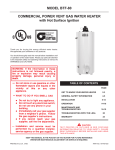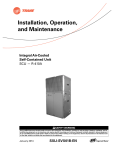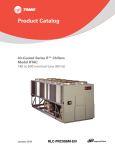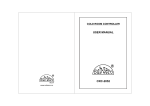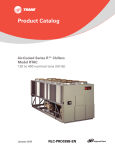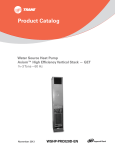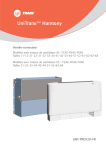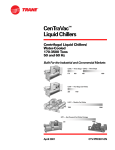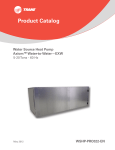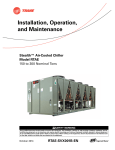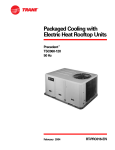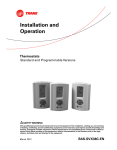Download Trane RTHD User's Manual
Transcript
Series R™ Helical Rotary Liquid Chillers Model RTHD 175-450Tons (60 Hz) 125-450Tons (50 Hz) Built for Industrial and Commercial Applications June 2006 RLC-PRC020-EN Introduction To meet a wide range of applications in the medium-tonnage, water-cooled market,Trane is proud to introduce the model RTHD helical rotary liquid chiller. The introduction of this next-generation chiller an exciting step forward in application versatility, ease of installation, control precision, reliability, energyefficiency, and operational cost-effectiveness.The new RTHD chiller is designed to deliver proven Series R performance, plus all the benefits of an advanced heat transfer design and a lowspeed, direct-drive compressor. © 2004 American Standard Inc. All rights reserved. Important Design Advances and New Features Major design advances include: • Higher full-load energy efficiency reduces both operating and life-cycle costs. • CH530 controls enable: - scrolling access to inputs and operating information via the LCD touch-screen display; - freedom from interoperability concerns with LonMark communications; - job-specific communication options that allow greater reporting flexibility. • Improved startup temperature capabilities and reduced sensitivity to condenser water temperatures alleviate the most common startup concerns. • Removed Liquid Vapor Separator, providing lighter unit weight and simplified refrigerant piping, for less expensive handling, separation, and installation. The industrial-grade design of the Series R helical rotary chiller is ideal for both industrial and commercial markets, in applications such as office buildings, hospitals, schools, retail buildings, and industrial facilities.The linear unloading compressor, wide operating temperature range, advanced controls, electronic expansion valve, short anti-recycle timers, and industry-leading efficiencies mean that this latestTrane Series R chiller is the perfect choice for tight temperature control in almost any application temperatures, and under widely varying loads. RLC-PRC020-EN Contents RLC-PRC020-EN Introduction 2 Features and Benefits 4 Options 6 Controls 8 Application Considerations 10 Selection Procedure 12 Model Nomenclature 14 General Data 16 Electrical Data and Connections 19 Dimensions and Weights 22 Mechanical Specifications 29 Conversion Table 30 3 Features and Benefits Application Versatility and High Performance • Screw compressor technology and the electronic expansion valve provide reliable performance in an expanded range of operating temperatures. •Tight water temperature control extends to operation of multiple chillers in parallel or series configurations, offering further system design flexibility for maximum efficiency. • Advanced design enables chilled water temperature control to +/- 0.5°F (.28°C) for flow changes up to 10 percent per minute, plus handling of flow changes up to 30 percent per minute for comfort cooling. •Two-minute stop-to-start and five-minute start-to-start anti-recycle timer allows tight chilled water temperature control in constant or transient low-load applications. • LonMark communications capability provides excellent, trouble-free interoperability. Applications in this catalog specifically excluded from the ARI certification program are: • Low temperature applications, including ice storage • Glycol • 50Hz units below 200 nominal tons • Generic Building Automation System points are available for easy access to operational information. • Extensive information on professional design selection and layout is available in a simple, highly readable electronic format. • Standard model RTHD configurations are in stock and available for immediate delivery, andTrane offers the fastest ship cycles in the industry for built-toorder units. • Industrial / Low Temperature Process Cooling – Excellent operating temperature range and precise control capabilities enable tight control with single chiller or series configuration. • Ice/Thermal Storage – Specifiers and operators benefit from dual setpoint control and industry-leading temperature, efficiency, and control capabilities, plus outstanding support through partnership with Calmac, a strongTrane partner providing proven installation examples, templates, and references that minimize design time and energy costs. • Heat Recovery – Maximum condenser temperature exceeds those of previous technologies, providing hot water and tight control that minimizes operating costs for the chilled water plant and boiler/hot water heater, and consistent dehumidification. Simple, Economical Installation • Compact size makes the model RTHD well suited for the retrofit and replacement market. • All units fit through standard doublewidth doors. • Bolt-together construction makes for fast, easy unit disassembly. • Small RTHD footprint saves valuable equipment room space and alleviates access concerns for most retrofit jobs. • Lightweight design simplifies rigging requirements, further reducing installation time requirements and costs. • Full factory refrigerant or nitrogen and oil charges reduce required field labor, materials, and installation cost. • Only evaporator and condenser water piping is required; no starter water cooling (with its associated safety concerns) or field piping is necessary. • Oil cooler and purge system connections have been eliminated. • Simple power connection simplifies overall installation. • Standard unit-mounted starter for Wye-Delta and Solid State eliminates additional jobsite installation considerations and labor requirements. •Trane has conducted extensive factory testing, and also offers options for inperson and/or documented system performance verification. • CH530 controls easily interface with Tracer Summit™ building automation systems through single twisted-pair wire. Pueblo Business Unit 4 RLC-PRC020-EN Features and Benefits State-of-the-Art, Precision Control • Microprocessor-based CH530 controls monitor and maintain optimal operation of the chiller and its associated sensors, actuators, relays, and switches, all of which are factory-assembled and extensively tested. • Easy interface with computers hosting Tracer Summit™ building automation/ energy management systems allows the operator to efficiently optimize comfort system performance and minimize operating costs. • PID (proportional integral derivative) control strategy ensures stable, efficient chilled water temperature control, maintaining +/- 1°F (0.56°C) control by proactively reacting to instantaneous load changes of up to 50 percent. • Adaptive Control™ attempts to maintain chiller operation under adverse conditions, when many other chillers might simply shut down. • Easy-to-use operator interface displays all operating and safety messages, with complete diagnostics information, on a highly readable panel with a scrolling touch-screen display. •The RTHD features a complete range of chiller safety controls. • Over 120 diagnostic and operating points are available, with standard displays including chiller current draw, condenser pressure, and evaporator pressure. Reliability and Ease of Maintenance • Direct drive, low-speed compressor – a simple design with only three moving parts – provides maximum efficiency, high reliability, and low maintenance requirements. • Electronic expansion valve, with fewer moving parts than alternative valve designs, offers highly reliable operation. • Suction gas-cooled motor stays uniformly cool at lower temperatures for longer motor life. RLC-PRC020-EN •TheTrane helical rotary compressor is a proven design resulting from years of research and thousands of test hours, including extensive testing under extraordinarily severe operating conditions. •Trane is the world’s largest manufacturer of large helical rotary compressors, with tens of thousands of commercial and industrial installations worldwide demonstrating a reliability rate of greater than 99 percent in the first year of operation. Operating and Life Cycle Cost-Effectiveness • Electronic expansion valve enables exceptionally tight temperature control and extremely low superheat, resulting in more efficient full-load and part-load operation than previously available. • Precise compressor rotor tip clearance ensures optimal efficiency. • Condenser and evaporator tubes use the latest heat transfer technology for increased efficiency. •The RTHD includes standard electrical demand limiting. • Chilled water reset based on return water temperature is standard. • High compressor lift capabilities and tight chilled water temperature control allow highly efficient system design with minimal operational concerns. Design capabilities include: • variable primary flow; • series chiller arrangements for evaporator and/or condenser; • low evaporator and condenser flow. 5 Options Insulation All low temperature surfaces are covered with factory installed 3/4 inch (19.05 mm) Armaflex II or equal (k=0.28) insulation, including the evaporator and water boxes, suction line, and motor housing. 3/8" foam insulation is used on the liquid level sensor and gas pump assembly, including piping. Low-Temperature Evaporator Addition of an oil cooler to the oil circuit enables evaporator operation down to minimum leaving water temperature of 10°F (-12.2°C). High-Temperature Condenser Addition of an oil cooler to the oil circuit enables condenser operation up to maximum leaving water temperature of 114°F (45.6°C). Smooth-Bore Condenser Tubes Smooth-bore copper or premium cupronickel condenser tubes, 3/4" (19.05 mm) in diameter with .035" (0.889 mm) wall thickness, are available for high fouling water applications. Refrigerant Isolation Valves Factory-installed condenser inlet and outlet refrigerant valves allow isolation of the full refrigerant charge in the condenser while servicing the chiller. Marine Water Boxes Addition of marine water boxes for the condenser allows tube cleaning without water pipe interference. 300 psig Evaporator and Condenser Water Boxes Water boxes are designed for 300 psig maximum waterside working pressure, and grooved pipe water connections are provided for ease of installation. 6 2-Way Condenser Water Regulating Valve For water regulation, a field-installed, 2-way butterfly-type (lug-style) valve, with integral electrical operator and factory-mounted valve actuator, is available.The single-phase, reversible motor can be factory-wired for 115 VAC, 60 Hz or 220 VAC, 50 Hz; the 2-way valve is field-wired and controlled by the chiller regulating valve control output; valves are available in 6" and 8" (152.4 and 203.2 mm) sizes. Nitrogen Charge Unit is shipped with a nitrogen holding charge in lieu of refrigerant. Seal Kit for Reassembly Ideal for situations when the bolt-together construction of the RTHD will be separated for installation, this seal kit provides replacement gaskets and rings for reassembly. Solid State Starter Solid State Starter is unit-mounted with a NEMA 1 gasketed enclosure.To extend starter life, contactors bypass current from the silicon control rectifiers (SCRs) after startup. Under/Over-Voltage Protection Unit receives protection against variations in voltage (current lag and spike protection is standard). Performance and Witness Tests ARI-certified RTHD Performance and WitnessTests are available, based on requested operating points, to certify chiller performance before delivery. Main Power Disconnect Options: Non-fused Disconnect A UL-approved non-fused molded case disconnect switch, factory pre-wired with terminal block power connections and equipped with a lockable external operator handle, is available to disconnect the chiller from main power. Standard Interrupting Capacity Circuit Breaker A UL-approved standard interrupting molded case capacity circuit breaker, factory pre-wired with terminal block power connections and equipped with a lockable external operator handle, is available to disconnect the chiller from main power. High Interrupting Capacity Circuit Breaker A UL-approved high interrupting molded case capacity circuit breaker, factory prewired with terminal block power connections and equipped with a lockable external operator handle, is available to disconnect the chiller from main power. Ground Fault Circuit Breaker A UL-approved standard interrupting molded case capacity circuit breaker with ground fault interrupting capability, factory pre-wired with terminal block connections and equipped with a lockable external operator handle, is available to disconnect the chiller from main power. RLC-PRC020-EN Options Control Options: Tracer Summit Communications Link to factory-installed, tested communication board, via single twistedpair wiring, addsTracer Summit communications to the system. LonTalk LCI-C Interface LonTalk (LCI-C) communications capabilities are available, with communication link via single twisted-pair wiring to factory-installed, tested communication board. External Chilled Water Setpoint External Chilled Water Setpoint is communicated to a factory-installed, tested communication board through a 210Vdc or 4-20mA signal. External Current Limiting External Current Limit Setpoint is communicated to a factory-installed, tested communication board through a 210Vdc or 4-20mA signal. External Base Loading External Base Loading is communicated to a factory-installed and tested communication board through a 2-10Vdc or 4-20mA signal. Ice Making Control Controls and safeties allow operation with brine temperatures down to 20°F (-6.7°C) , and dual setpoints enable both ice making and daytime comfort cooling. RLC-PRC020-EN Programmable Relays Default-set, factory-installed, programmable relays allow the operator to select four relay outputs from a list of eight. Available relays are: AlarmLatching, Alarm-Auto Reset, General Alarm, Warning, Chiller Limit Mode, Compressor Running, Head Pressure Relief Request, andTracer Control. Chilled Water Reset – Outdoor Air Temperature Controls, sensors, and safeties allow reset of chilled water temperature, based on temperature signal, during periods of low outdoor air temperature (chilled water reset based on return chilled water temperature is standard). Condenser-Regulating Valve Control Chiller applies a Proportional Integrative Control (PID) algorithm to control water regulating valve via 0-10Vdc signal. Percent of Full Run Load Amps Output Control system indicates the active chiller percent of full run load amps, based on a 0-10Vdc signal. Condenser Pressure Output Control system indicates chiller differential pressure or condenser pressure, based on a 0-10Vdc signal. Refrigerant Monitor Input Control system indicates refrigerant monitor status of 0-100 or 0-1000 ppm (user selectable), based on a 2-10Vdc / 4-20 mA signal. 7 Controls LCD Touch-Screen Display with Multi-Language Support The standard DynaView display provided with the CH530 control panel features an LCD touch-screen, allowing access to all operational inputs and outputs.This display supports eleven languages: English, Chinese, Dutch, French, German, Italian, Japanese, Korean, Portugese, Spanish andThai. Additional Display Features Include: • LCD touch-screen with LED backlighting, for scrolling access to input and output operating information • Weather-proof enclosure for reliable operation in non-standard indoor environments • Spin value buttons to allow continuously variable setpoints when applicable • Radio and action buttons for easy, onetime actions and settings • Single-screen, folder/tab-style display of all available information on individual components (evaporator, condenser, compressor, etc.) • Automatic and immediate stop capabilities for standard or immediate manual shutdown • Manual override indication • Password entry/lockout system to enable or disable display 8 • Fast, easy access to available chiller data in tabbed format, including: — Modes of operation, including normal cooling and icemaking — Water temperatures and setpoints — Loading and limiting status and setpoints — Average line current — Outdoor air temperature — Start/stop differential timers — Auto/Manual mode for EXV, slide valve, and head pressure control — Pump status and override — Chilled water reset, start point, ratio, and outdoor start point — External setpoints, including: - chilled water - current limit - ice building - base loading — Display specifics, including: - date - format - time - display lockout - display units - language setting - Reports, listed on a single tabbed screen for easy access, including: • ASHRAE, containing all guideline 3 report information • Evaporator • Condenser • Compressor — Evaporator, condenser, and compressor reports containing all operational information on individual components, including: - Water and air temperatures - Refrigerant levels, temperatures, and approach - Oil pressure - Flow switch status - EXV position - Head pressure control command - Compressor starts and run-time - Line phase percent RLA, amps, and volts — Alarm and diagnostic information, including: - Flashing alarms with touch-screen button for immediate address of alarm condition - Scrollable list of last ten active diagnostics - Specific information on applicable diagnostic from list of over onehundred - Automatic or manual resetting diagnostic types RLC-PRC020-EN Controls Trane Chiller Plant Automation Trane’s depth of experience in chillers and controls makes us a well-qualified choice for automation of chiller plants using aircooled Series R® chillers®.The chiller plant control capabilities of theTraneTracer Summit® building automation system are unequaled in the industry. Our chiller plant automation software is fully preengineered and tested. It is a standard software application, not custom programming which can prove to be difficult to support, maintain, and modify. Energy Efficiency Trane chiller plant automation intelligently sequences starting of chillers to optimize the overall chiller plant energy efficiency. Individual chillers are designated to operate as base, peak, or swing based on capacity and efficiency. Sophisticated software automatically determines which chiller to run in response to current conditions.The software also automatically rotates individual chiller operation to equalize runtime and wear between chillers. Trane chiller plant automation enables unique energy-saving strategies. An example is controlling pumps, and chillers from the perspective of overall system energy consumption.The software intelligently evaluates and selects the lowest energy consumption alternative. Regulatory Compliance Documentation Comprehensive documentation of refrigerant management practices is now a fact of life.Trane chiller plant automation generates the reports mandated in ASHRAE Guideline 3. Keeping Operators Informed A crucial part of efficiently running a chiller plant is assuring that the operations staff is instantly aware of what is happening in the plant. Graphics showing schematics of chillers, piping, pumps, and towers clearly depict the chiller plant system, enabling building operators to easily monitor overall conditions. Status screens display both current conditions and upcoming automated control actions to add or subtract chiller capacity. Series R™ and other chillers can be monitored and controlled from a remote location. RLC-PRC020-EN Tracer Summit features standard report templates listing key operating data for troubleshooting and verifying performance. Reports for each type of Trane chiller and three and six-chiller systems are also standard. Detailed reports showing chiller runtimes aid in planning for preventative maintenance. Swift Emergency Response We understand the importance of maintaining chilled water production while protecting your chillers from costly damage. If no water flow is detected to a chiller’s piping, the start sequence is aborted to protect the chiller.The next chiller in the sequence is immediately started to maintain cooling. In the event of a problem, the operator receives an alarm notification and diagnostic message to aid in quick and accurate troubleshooting. A snapshot report showing system status just prior to an emergency shutdown helps operators determine the cause. If emergency conditions justify an immediate manual shutdown, the operator can override the automatic control. Integrated Comfort™ Capabilities When integrated with aTracer Summit building management system performing building control,Trane chiller plant automation coordinates withTracer Summit applications to optimize the total building operation. With this system option, the full breadth ofTrane’s HVAC and controls experience are applied to offer solutions to many facility issues. If your project calls for an interface to other systems,Tracer Summit can share data via BACnet™, the ASHRAE open systems protocol. LonTalk Chiller Controls LonTalk is a communications protocol developed by the Echelon Corporation. The LonMark association develops control profiles using the LonTalk communication protocol. LonTalk is a unit level communications protocol, unlike BACNet used at the system level. LonTalk Communications Interface for Chillers (LCI-C) provides a generic automation system with the LonMark chiller profile inputs/outputs. In addition to the standard points,Trane provides other commonly used network output variables for greater interoperability with any automation system. The complete reference list ofTrane LonTalk points is available on the LonMark website. Trane controls or another vendor’s system can use the predefined list of points with ease to give the operator a complete picture of how the system is running. Hardwire Points Remote devices wired from the control panel are another reliable method of providing auxiliary control to a building automation system. Inputs and outputs can be communicated via a typical 4-20 mA electrical signal (or an equivalent Vdc signal of 0-10 or 2-10) or by utilizing contact closures. • External Chilled Water Setpoint • External Current Limit Setpoint • Condenser-Regulating Valve Control • Percent of Full Run Load Amps Output • Condenser Pressure Output • Refrigerant Monitor Input • Programmable Relays Allows the selection of 4 relay outputs from a list of eight different default settings: Alarm-Latching, Alarm-Auto Reset, General Alarm, Warning, Chiller Limit Mode, Compressor Running, Head Pressure Relief Request, andTracer Control. These contact closures may be used to trigger jobsite supplied audible or visual alarms • Ice Making Control Provides an interface with ice making control system and safeties, enabling both ice making and daytime comfort cooling • Chilled WaterTemperature Reset Supplies controls, sensors and safeties to reset the chilled water temperature setpoint based upon return water temperature (standard) or outdoor air temperature (optional) 9 Application Considerations Condenser Water Temperatures Reduced sensitivity to condenser water startup temperatures is one major enhancement in the newest-generation water-cooled Series R chiller. With the model RTHD chiller, a condenser water control method is necessary only if the unit starts with entering water temperatures below 55°F (12.8°C), or between 45°F (7.2°C) and 55°F (12.8°C), when a temperature increase of 1°F (0.56°C) per minute to 55°F (12.8°) is not possible. When the application requires startup temperatures below the prescribed minimums, a variety of options are available.To control a 2-way or 3-way valve,Trane offers a Condenser Regulating Valve Control option for the CH530 controls.This option enables the CH530 controls to send a signal for opening and closing the valve as necessary to maintain chiller differential pressure. The 2-way valves are available as a ship-with option.Tower bypass is also a valid control method if the chiller temperature requirements can be maintained. Trane Series R chillers start and operate successfully and reliably over a range of load conditions with controlled entering condenser water temperature. Reducing the condenser water temperature is an effective method of lowering chiller 10 power input required, but the ideal temperature for optimizing total system power consumption will depend on the overall system dynamics. From a system perspective, some improvements in chiller efficiency may be offset by the increased tower fan and pumping costs required to achieve the lower tower temperatures. Contact your local Trane systems solution provider for more information on optimizing system performance. The minimum acceptable refrigerant pressure differential between condenser and evaporator is 23 psid.The chiller control system will attempt to obtain and maintain this differential at startup, but for continuous operation a design should maintain a 25°F (13.9°C) differential from evaporator leaving water temperature to condenser leaving water temperature. Variable Evaporator Flow and Short Evaporator Water Loops Variable evaporator flow is an energysaving design strategy which has quickly gained acceptance as advances in chiller and controls technology have made it possible. With its linear unloading compressor design and advanced CH530 controls, the RTHD has excellent capability to maintain leaving water temperature control within +/-0.5°F (0.28°C) , even for systems with variable evaporator flow and small chilled water volumes. Some basic rules should be followed whenever using these system design and operational savings methods with the RTHD.The proper location of the chilled water temperature control sensor is in the supply (outlet) water.This location allows the building to act as a buffer, and it assures a slowly changing return water temperature. If there is insufficient water volume in the system to provide an adequate buffer, temperature control can be lost, resulting in erratic system operation and excessive compressor cycling.To ensure consistent operation and tight temperature control, the chilled water loop should be at least two minutes. If this recommendation cannot be followed, and tight leaving water temperature control is necessary, a storage tank or larger header pipe should be installed to increase the volume of water in the system. For variable primary flow applications, the rate of chilled water flow change should not exceed 10 percent of design per minute to maintain +/-0.5°F (0.28°C) leaving evaporator temperature control. For applications in which system energy savings is most important and tight temperature control is classified as +/-2°F (1.1°C), up to 30 percent changes in flow per minute are possible. Flow rates should be maintained between the minimum and maximum allowed for any particular chiller configuration. RLC-PRC020-EN Application Considerations Series Chiller Arrangements Another energy-saving strategy is to design the system around chillers arranged in series, on the evaporator, condenser, or both.The actual savings possible with such strategies depends on the application dynamics and should be researched by consulting yourTrane Systems Solutions Representative and applying theTrane System Analyzer program. It is possible to operate a pair of chillers more efficiently in a series chiller arrangement than in a parallel arrangement. It is also possible to achieve higher entering-to-leaving chiller differentials, which may, in turn, provide the opportunity for lower chilled water design temperature, lower design flow, and resulting installation and operational cost savings.TheTrane screw compressor also has excellent capabilities for “lift,” which affords an opportunity for savings on the evaporator and condenser water loops. Like series arrangements on the evaporator, series arrangements on the condenser may enable savings.This approach may allow reductions in pump and tower installation and operating costs. Maximizing system efficiency requires that the designer balance performance considerations for all system components; the best approach may or may not involve multiple chillers, or series arrangement of the evaporators and/or condensers. This ideal balance of design integrity with installation and operating cost considerations can also be obtained by consulting aTrane representative and applying theTrane System Analyzer program. Water Treatment The use of untreated or improperly treated water in chillers may result in scaling, erosion, corrosion, and algae or slime buildup. It is recommended that the services of a qualified water treatment specialist be engaged to determine what treatment, if any, is advisable.Trane assumes no responsibility for the results of using untreated or improperly treated water. Water Pumps Where noise limitation and vibration-free operation are important,Trane strongly encourages the use of 1750-rpm (60 Hz), 1450-rpm (50 Hz) pumps. Specifying or using 3600-rpm (60 Hz), 3000-rpm (50 Hz) condenser water and chilled water pumps must be avoided, because such pumps may operate with objectionable levels of noise and vibration. In addition, a low frequency beat may occur due to the slight difference in operating rpm between 3600-rpm (60 Hz), 3000-rpm (50 Hz) water pumps and Series R chiller motors. Important Note:The chilled water pump must not be used to stop the chiller. Acoustic Considerations For chiller sound ratings, installation tips, and considerations on chiller location, pipe isolation, etc., refer to theTrane Water-Cooled Series R Chillers Sound Ratings and Installation Guide. Using the information provided in this bulletin, contact a certified sound consultant to aid in proper mechanical room design and treatment. Figure 1. Typical series chiller arrangement RLC-PRC020-EN 11 Selection Procedure Trane Series R chiller performance is rated in accordance with the ARI Standard 550/590-2003 Certification Program. Chiller selection assistance and performance information can be obtained by using the Series R chiller selection program, available through local Trane sales offices. Performance The computerized Series R chiller selection program provides performance data for each possible chiller selection at both full-load and part-load design points, as required. It should be noted that changing the number of water passes or the water flow rates will generally alter the performance of a particular chiller.To attain maximum benefit from the wide range of chiller models and options available, designers are encouraged to first develop performance specifications and then use the chiller selection program to optimize all selections.This will help ensure selection of the compressorevaporator-condenser combination that most closely meets the job requirements. To optimize system performance, all selections should also be balanced with other system components. Fouling Factors ARI Standard 550 includes a definition of clean tube fouling.The recommended standard fouling adjustments are 0.0001 hr-sq ft-deg F/Btu (0.0176 sq m-deg C/kW) for the evaporator and 0.00025 hr-sq ft deg F/Btu (0.044 sq m-deg C/kW) for the condenser, from an increment of 0.0000 “clean.” Chiller specifications should be developed using the most current standard fouling factors. 12 Part Load Performance Actual air-conditioning system loads are frequently less than full-load design conditions. Depending on the number of chillers on the job and the load profile, chillers may operate at full load a small percentage of the time. With their excellent part-load performance characteristics and highly energy-efficient operation, Series R chillers can provide significant operating savings at these part-load conditions. System Considerations Part-load chiller operation is frequently associated with reduced condenser water temperatures. However, rather than focusing only on the chiller, it is important to balance these temperatures to achieve the most efficient system operation possible. At part-load operation, the heat rejected to the cooling tower is less than at full-load operation. Part-load chiller operation is also typically associated with reduced outside wet bulb temperatures, resulting in improved cooling tower performance.The net result of reduced heat rejection and lower wet bulb temperatures can be cooler condenser water entering the chiller, ultimately improving unit performance. However, this does not improve pump or tower efficiency.To achieve the most efficient system operation possible, it is best to minimize the total power draw of the chiller, tower, and pumps, which may not mean limiting the condenser water temperature to what the tower can provide.To determine specific unit and system part-load performance for chiller selection purposes, use the Series R chiller computer selection program or contact the localTrane sales office. RLC-PRC020-EN Selection Procedure Unit Performance with Fluid Media Other Than Water Series R chillers can be provided with a wide variety of fluid media other than water, including ethylene glycol and propylene glycol— in the evaporator, condenser or both. Chillers using media other than water are excluded from the ARI 550/590-2003 Certification Program, but are rated in accordance with ARI Standard 550/590-2003. Trane factory performance tests are only performed with water as the cooling and heatrejection media. When considering selection of media other than water, contact the localTrane sales office for chiller selections and factory performance testing information. Fluid media other than water lowers the heat transfer coefficient, and therefore reduces chiller performance. In general, it is good practice to hold the percent glycol added to within the minimum allowed by theTrane selection program, based on either (a) unit operating temperatures, or (b) the operating temperatures the evaporator or condenser water will experience under its full range of conditions. Adding more glycol than required for the specific application is equivalent to selecting a less efficient chiller. Lower-viscosity glycols such as ethylene will have less adverse impact on chiller performance than higherviscosity glycols such as propylene. Evaporator and Condenser Pressure Drop Pressure drop data is determined by the Series R chiller computer selection program available through localTrane sales offices. Dimensional Drawings Dimensional drawings provided for selection purposes illustrate overall measurements of the unit.The recommended service clearances are those required to easily service the Series R chiller. Electrical Data Tables Compressor motor electrical data is provided in the data section for each compressor size. Rated load amperes (RLA), locked rotor wye amperes (LRA) and expected inrush for the Wye-delta and Solid State Starter configurations are shown. Although the terms “LRA” and “expected inrush” are often used interchangeably, the distinction applied here is that LRA is the rated inrush for the motor, but expected inrush is that allowed by the starter, based on the specific configuration. Selecting starters in the Wye-delta or Solid State configuration lowers expected inrush vs. the Delta (or “acrossthe-line”) configuration. A Solid State Starter configuration lowers the expected inrush by approximately 50 percent, while Wye-Delta lowers it by approximately 66 percent. The RLA is based on the motor’s performance when reaching full rated horsepower.The kW rating of the motor will equal or exceed the kW requirement indicated by the Series R computer selection program at design conditions. If motor kW draw at design conditions is less than the kW rating of the motor, the RLA at design conditions is determined by multiplying the motor RLA (at the desired voltage) by this ratio: design kW/ motor kW rating.This calculation is performed within the Series R chiller computer selection program, making RLA available as part of the design predictions. Predicted values include power factor variation from point to point. A voltage utilization range is tabulated for each voltage listed. Series R chillers are designed to operate satisfactorily over a utilization range of ±10 percent of the standard design voltages: (a) 200 V, 230 V, 380 V, 460 V, and 575 V for 60 Hertz, 3phase, and (b) 380 V, 400 V, 415 V for 50 Hertz, 3-phase. All catalog dimensional drawings are subject to change, and current submittal drawings should be referenced for more detailed dimensional information. Dimensional drawings are also available from the selection program. Contact the localTrane sales office for submittal information. RLC-PRC020-EN 13 Model Nomenclature RTH D 1,2,3 4 U 5 D 6 2 7 F 8 Digits 01, 02, 03 – Series R™ RTH = Series R Digit 04 – Dev Sequence D = 4th Major Development Digit 05 – Design Control U = WCBU Digit 06 – Compressor Frame B = B Compressor C = C Compressor D = D Compressor E = E Compressor Digit 07 – Compressor Capacity 1 = Smaller Capacity for Frame 2 = Larger Capacity for Frame 3 = 50Hz Capacity Digit 08 – Unit Power Supply A = 200V/60Hz/3Ph power C = 230V/60Hz/3Ph power D = 380V/60Hz/3Ph power R = 380V/50Hz/3Ph power T = 400V/50Hz/3Ph power U = 415V/50Hz/3Ph power F = 460V/60Hz/3Ph power H = 575V/60Hz/3Ph power 0 9 A0 10,11 U 12 A 13 G 14 3 15 A 16 4 17 A 19 Digit 09 – Specials X = No specials C = All specials denoted by digits elsewhere S = Uncategorized special not denoted by other digits Digits 10, 11 – Design Sequence ** = First Design, etc. increment when parts are affected for service purposes Digit 12 – Agency Listing X = No agency listing U = C/UL Digit 13 – Pressure Vessel Code A = ASME L = Chinese Pressure Vessel Code Digit 14 – Evaporator Frame B = B Frame C = C Frame D = D Frame E = E Frame F = F Frame G = G Frame Digit 15 – Evaporator Capacity 1 = Tube count #1 2 = Tube count #2 3 = Tube count #3 4 = Tube count #4 5 = Tube count #5 6 = Tube count #6 Digit 16 – Evaporator Tube Type A = Enhanced Fin Copper Digit 17 – Evaporator Water Pass Configuration 2 = 2 pass 3 = 3 pass 4 = 4 pass 14 L 18 L 20 G 21 3 22 F 23 2 24 L 25 A 26 L 27 Digit 18 – Evaporator Water Connection L = Left Hand Evaporator Connection R = Right Hand Evaporator Connection Digit 19 – Evaporator Connection Type A = Standard Grooved Pipe Digit 20 – Evaporator Waterside Pressure L = 150 psi H = 300 psi Digit 21 – Condenser B = B Frame D = D Frame E = E Frame F = F Frame G = G Frame Digit 22 – Condenser Capacity 1 = Tube count #1 2 = Tube count #2 3 = Tube count #3 4 = Tube count #4 5 = Tube count #5 Digit 23 – Condenser Tube Type A = Enhanced Fin Copper B = Smooth Bore Copper C = Smooth Bore 90/10 CU/NI Digit 24 – Condenser Passes 2 = 2 Pass Digit 25 – Condenser Water Connection L = Left Hand Connection R = Right Hand Connection Digit 26 – Condenser Connection Type A = Standard Grooved Pipe C = Marine Digit 27 – Condenser Waterside Pressure L = 150 psi H = 300 psi RLC-PRC020-EN Model Nomenclature A V 28 29 X 30 Q 31 X 32 E 33 X A 34 35 A 36 Digit 28 – Condenser Leaving Water Temperature A = Standard Digit 29 – Refrigerant Specialties X = No Refrigerant Isolation Valves V = With Refrigerant Isolation Valves Digit 30 – Oil Cooler X = Without Oil Cooler C = With Oil Cooler Digit 31 – Thermal Insulation X = No Insulation Q = Factory Installed Insulation Digit 32 – Acoustic Insulation X = No Insulation A = Standard Insulation B 37 D 38 Y 444 D 39 40,41,42 43 A 44 X 45 A 46 Digit 38 – Factory Test X = Standard Test C = Witness Test D = Performance Test Digit 39 – Starter Type Y = Wye Delta Closed Transition Starter A = Solid State Starter Digits 40, 41, 42 – Design RLA (for starter) *** = Selection Assigned Digit 43 – Power Line Connection Type A = Terminal Blocks B = Mechanical Disconnect Switch D = Circuit Breaker F = High Interrupt Circuit Breaker H = Ground Fault Circuit Breaker J = Ground Fault High Interrupt Circuit Breaker Digit 33 – Label and Literature Language C = Spanish E = English F = French Digit 44 – Enclosure Type A = NEMA 1 Digit 34 – Safety Devices X = Standard Digit 45 – Under/Over Voltage Protection X = None U = With Under/Over Voltage Protection Digit 35 – Factory Charge A = Factory Refrigerant Charge (134a) B = Factory Nitrogen Charge Digit 36 – Shipping Package A = No Skid (standard) B = Shrink Wrap C = Skid D = Skid + Shrink Wrap J = Special Digit 37 – Flow Switch X = No Flow Switch A = Evaporator (NEMA 1) B = Evaporator and Condenser (NEMA 1) C = Evaporator (NEMA 4) D = Evaporator and Condenser (NEMA 4) RLC-PRC020-EN 4 47 Digit 46 – Operator Interface Language A = Dyna-View/English B = Dyna-View/French C = Dyna-View/Italian D = Dyna-View/Spanish E = Dyna-View/German F = Dyna-View/Dutch G = Dyna-View/Traditional Chinese H = Dyna-View/Simple Chinese J = Dyna-View/Japanese K = Dyna-View/Portuguese L = Dyna-View/Korean M = Dyna-View/Thai X 48 X 49 X 50 R 51 X 52 V 53 X 54 Digit 48 – External Chilled Water and Current Limit Setpoint X = None 4 = 4-20mA input 2 = 2-10Vdc Digit 49 – External Base Loading X = None 4 = 4-20mA input 2 = 2-10Vdc input Digit 50 – Icemaking X = None A = Icemaking with Relay B = Icemaking without Relay Digit 51 – Programmable Relays X = None R = With Digit 52 – Chilled Water Reset X = Chilled Water Reset – Return Water T = Chilled Water Reset – Outdoor Air Temperature Digit 53 – Control Outputs X = None V = Condenser Regulating Valve Control & Percent RLA P = Condenser Pressure (% HPC) & Percent RLA D = Chiller Differential Pressure & Percent RLA Digit 54 – Refrigerant Monitor Input X = None A = 100 ppm / 4-20mA B = 1000 ppm / 4-20mA C = 100 ppm / 2-10Vdc D = 1000 ppm / 2-10Vdc Digit 47 – Digital Communication Interface X = None 4 = Tracer Interface 5 = LCI-C (LonTalk) 15 General Data Nominal Data Nominal Compressor B1 Tonnage (60 Hz) 175-200 Tonnage (50 Hz) 125-150 B2 200-225 150-175 C1 225-275 175-225 C2 275-325 225-275 D1 325-400 275-325 D2 375-450 300-350 D3 E3 N/A N/A 325-375 375-450 Notes: 1. Chiller selections can be optimized through the use of the ARI-Certified Series R selection program and by contacting your local Trane sales office. General Data Compressor Code B1 B1 B2 B2 C1 C1 C1 C2 C2 C2 D1 D1 D11 D12 D2/D3 D2/D3 D2/D31 D2/D32 E3 E3 E31 E32 Evaporator Code B1 C1 B2 C2 D6 D5 E1 D4 D3 F2 D1 F1 G1 G2 D2 F2 G2 G3 D2 F2 G2 G3 Condenser Code B1 D1 B2 D2 E5 E4 F1 E4 E3 F3 E1 F2 G1 G2 E2 F3 G1 G3 E2 F3 G1 G3 Evaporator Water Storage Gallons Liters 41 155 55 208 45 170 58 220 45 170 52 197 82 310 52 197 78 295 107 405 69 261 102 386 136 515 144 545 74 280 107 405 144 545 159 602 74 280 107 405 144 545 159 602 Condenser Water Storage Gallons Liters 28 106 31 117 29 110 34 129 29 110 32 121 60 226 32 121 47 178 61 231 44 166 57 216 79 299 91 344 47 178 61 231 79 299 97 367 47 178 61 231 79 299 97 367 Refrigerant Type HFC-134a HFC-134a HFC-134a HFC-134a HFC-134a HFC-134a HFC-134a HFC-134a HFC-134a HFC-134a HFC-134a HFC-134a HFC-134a HFC-134a HFC-134a HFC-134a HFC-134a HFC-134a HFC-134a HFC-134a HFC-134a HFC-134a Refrigerant Charge lb 410 490 410 490 490 490 525 490 490 625 475 625 --700 475 625 --700 475 625 --700 kg 186 222 186 222 222 222 238 222 222 284 216 284 --318 216 284 --318 216 284 --318 Notes: 1. 50 Hz units only. 2. 60 Hz units only. 16 RLC-PRC020-EN General Data Water Flow Rates Minimum/Maximum Evaporator Flow Rates (Gallons/Minute ) Two Pass Evaporator Code B1 B2 C1 C2 D1 D2 D3 D4 D5 D6 E1 F1 F2 G1 G2 G3 Min 253 288 320 347 415 450 486 351 351 293 450 563 604 ———- Max 1104 1266 1412 1531 1812 1980 2131 1542 1542 1287 1980 2478 2667 ———- Three Pass Nominal Conn Size (In.) 8 8 8 8 8 8 8 8 8 8 8 10 10 ———- Min 168 192 213 232 275 300 324 234 234 196 300 376 404 505 550 622 Max 736 844 941 1022 1206 1320 1417 1028 1028 860 1320 1655 1780 2218 2413 2732 Four Pass Nominal Conn Size (In.) 6 6 6 6 8 8 8 8 8 8 8 8 8 10 10 10 Min —————————————379 411 466 Nominal Conn Size (In.) —————————————8 8 8 Max —————————————1666 1807 2050 Notes: 1. Minimum flow rates are based on water only. 2. All water connections are grooved pipe. Minimum/Maximum Evaporator Flow Rates (Liters/Second) Two Pass Evaporator Code B1 B2 C1 C2 D1 D2 D3 D4 D5 D6 E1 F1 F2 G1 G2 G3 Min 16 18 20 22 26 28 31 22 22 18 28 36 38 ———- Max 70 80 89 97 114 125 134 97 97 81 125 156 168 ———- Three Pass Nominal Conn Size (mm) 200 200 200 200 200 200 200 200 200 200 200 250 250 ———- Min 11 12 13 15 17 19 20 15 15 12 19 24 25 32 35 39 Four Pass Nominal Max Conn Size (mm) 46 150 53 150 59 150 65 150 76 200 83 200 89 200 65 200 65 200 54 200 83 200 104 200 112 200 140 250 152 250 172 250 Min —————————————24 26 29 Max —————————————105 114 129 Nominal Conn Size (mm) —————————————200 200 200 Notes: 1. Minimum flow rates are based on water only. 2. All water connections are grooved pipe. Minimum/Maximum Condenser Flow Rates (Gallons/Minute) Minimum/Maximum Condenser Flow Rates (Liters/Second) Two Pass Condenser Code B1 B2 D1 D2 E1 E2 E3 E4 E5 F1 F2 F3 G1 G2 G3 Min 193 212 193 212 291 316 325 245 206 375 355 385 444 535 589 Max 850 935 850 935 1280 1390 1420 1080 910 1650 1560 1700 1960 2360 2600 Two Pass Nominal Conn Size (In.) 6 6 6 6 8 8 8 8 8 8 8 8 8 8 8 Notes: 1. Minimum flow rates are based on water only. 2. All water connections are grooved pipe. RLC-PRC020-EN Condenser Code B1 B2 D1 D2 E1 E2 E3 E4 E5 F1 F2 F3 G1 G2 G3 Min 12 13 12 13 18 20 21 15 13 24 22 24 28 34 37 Max 54 59 54 59 81 88 90 68 57 104 98 107 124 149 164 Nominal Conn Size (mm) 150 150 150 150 200 200 200 200 200 200 200 200 200 200 200 Notes: 1. Minimum flow rates are based on water only. 2. All water connections are grooved pipe. 17 General Data Brine Flow Rates Minimum/Maximum Evaporator Flow Rates (GPM) Two Pass Evaporator Code B1 B2 C1 C2 D1 D2 D3 D4 D5 D6 E1 F1 F2 G1 G2 G3 Min 303 346 346 375 498 541 584 422 422 352 487 676 725 ———- Max 1104 1266 1412 1531 1812 1980 2131 1542 1542 1287 1980 2478 2667 ———- Three Pass Nominal Conn Size (In.) 8 8 8 8 8 8 8 8 8 8 8 10 10 ———- Min 200 233 254 276 330 357 389 281 281 233 357 454 487 606 660 747 Max 736 844 941 1022 1206 1320 1417 1028 1028 860 1320 1655 1780 2218 2413 2732 Four Pass Nominal Conn Size (In.) 6 6 6 6 8 8 8 8 8 8 8 8 8 10 10 10 Min —————————————454 492 557 Nominal Conn Size (In.) —————————————8 8 8 Max —————————————1666 1807 2050 Notes: 1. Minimum flow rates are based on brine solution. 2. All water connections are grooved pipe. Minimum/Maximum Evaporator Flow Rates (Liters/Second) Two Pass Evaporator Code B1 B2 C1 C2 D1 D2 D3 D4 D5 D6 E1 F1 F2 G1 G2 G3 Min 19 22 22 23 31 34 37 27 27 22 28 43 46 ———- Max 70 80 89 97 114 125 134 97 97 81 125 156 168 ———- Three Pass Nominal Conn Size (mm) 200 200 200 200 200 200 200 200 200 200 200 250 250 ———- Min 13 15 16 17 21 23 25 18 18 15 23 29 31 38 42 47 Four Pass Nominal Max Conn Size (mm) 46 150 53 150 59 150 65 150 76 200 83 200 89 200 65 200 65 200 54 200 83 200 104 200 112 200 140 250 152 250 172 250 Min —————————————29 31 35 Max —————————————105 114 129 Nominal Conn Size (mm) —————————————200 200 200 Notes: 1. Minimum flow rates are based on brine solution. 2. All water connections are grooved pipe. Minimum/Maximum Condenser Flow Rates (GPM) Minimum/Maximum Condenser Flow Rates (Liters/Second) Two Pass Two Pass Condenser Code B1 B2 D1 D2 E1 E2 E3 E4 E5 F1 F2 F3 G1 G2 G3 Min 230 255 230 255 350 380 390 295 250 450 430 460 530 650 710 Max 850 935 850 935 1280 1390 1420 1080 910 1650 1560 1700 1960 2360 2600 Nominal Conn Size (In.) 6 6 6 6 8 8 8 8 8 8 8 8 8 8 8 Notes: 1. Minimum flow rates are based on brine solution. 2. All water connections are grooved pipe. 18 Condenser Code B1 B2 D1 D2 E1 E2 E3 E4 E5 F1 F2 F3 G1 G2 G3 Min 15 16 15 16 22 24 25 19 16 28 27 29 33 41 45 Max 54 59 54 59 81 88 90 68 57 104 98 107 124 149 164 Nominal Conn Size (mm) 150 150 150 150 200 200 200 200 200 200 200 200 200 200 200 Notes: 1. Minimum flow rates are based on brine solution. 2. All water connections are grooved pipe. RLC-PRC020-EN Electrical Data and Connections Compressor Motor Electrical Data (60 Hertz) Compressor Code B1, B2 C1, C2 D1, D2 Nominal Voltage Voltage Utilization Range Max kW RLA @ Max kW LRAY LRAD Max kW RLA @ Max kW LRAY LRAD Max kW RLA @ Max kW LRAY LRAD 200 180/ 220 174 557 970 3103 249 812 1173 3634 329 888 1690 5477 230 208/ 254 174 484 818 2617 249 698 936 2901 329 888 1532 4966 380 342/ 418 174 291 488 1561 249 421 558 1727 329 549 850 2755 460 414/ 506 174 241 400 1280 249 349 469 1453 329 455 730 2366 575 516/ 633 174 193 329 1053 249 279 375 1162 329 367 612 1984 Notes: 1. See Selection Procedure Section for details. 2.The RLA @ Max kW is based on the performance of the motor developing full rated horsepower. 3. Electrical component sizing should be based on actual jobsite operating conditions.This factor can be obtained through the use of the Series R chiller selection program available through localTrane sales offices. Compressor Motor Electrical Data (50 Hertz) Compressor Code B1, B2 C1, C2 D1, D2, D3 E3 Nominal Voltage Voltage Utilization Range Max kW RLA @ Max kW LRAY LRAD Max kW RLA @ Max kW LRAY LRAD Max kW RLA @ Max kW LRAY LRAD Max kW RLA @ Max kW LRAY LRAD 380 342/ 418 139 233 391 1229 201 349 456 1414 271 455 711 2303 288 488 711 2303 400 360/ 440 145 233 412 1296 209 349 480 1488 280 455 748 2424 301 488 748 2424 415 374/ 457 148 233 428 1348 213 349 498 1544 284 455 776 2515 306 488 776 2515 Notes: 1. See Selection Procedure Section for details. 2.The RLA @ Max kW is based on the performance of the motor developing full rated horsepower. 3. Electrical component sizing should be based on actual jobsite operating conditions.This factor can be obtained through the use of the Series R chiller selection program available through localTrane sales offices. Electrical Connections Starter Panel Connection Terminals Only Main Circuit Breaker or Non-Fused Disconnect Switch Selection RLA 000-760 761-888 000-185 186-296 297-444 445-592 593-888 Lug Size L1-L3 (Each Phase) (2) #4-500 MCM (4) 4/0-500 MCM (1) #4-350 MCM (2) 2/0-250 MCM (2) 3/0-350 MCM (2) #1-500 MCM (4) 4/0-500 MCM Note: 1. Lug sizes are independent of starter type. RLC-PRC020-EN 19 Electrical Data and Connections 20 RLC-PRC020-EN Electrical Data and Connections RLC-PRC020-EN 21 Dimensions and Weights Shipping and Operating Weights Compressor Code B1 B1 B2 B2 C1 C1 C1 C2 C2 C2 D1 D1 D1 D1 D2, D3 D2, D3 D2, D3 D2, D3 E3 E3 E3 E3 Evaporator Code B1 C1 B2 C2 D6 D5 E1 D4 D3 F2 D1 F1 G1 G2 D2 F2 G2 G3 D2 F2 G2 G3 Condenser Code B1 D1 B2 D2 E5 E4 F1 E4 E3 F3 E1 F2 G1 G2 E2 F3 G1 G3 E2 F3 G1 G3 Operating Weight (lbs) (kg) 9,867 4,476 10,554 4,787 10,019 4,545 10,653 4,832 13,397 6,077 13,673 6,202 15,818 7,175 13,672 6,201 15,044 6,824 17,560 7,965 15,385 6,978 17,537 7,955 20,500 9,299 21,065 9,555 15,570 7,062 18,220 8,264 20,700 9,389 21,641 9,816 15,728 7,134 18,356 8,326 20,800 9,435 21,786 9,882 Shipping Weight (lbs) (kg) 9,292 4,215 9,837 4,462 9,402 4,265 9,953 4,515 12,780 5,797 12,973 5,884 14,718 6,676 12,972 5,884 14,002 6,351 16,168 7,334 14,443 6,551 16,187 7,342 18,600 8,437 19,107 8,667 14,562 6,605 16,820 7,629 18,700 8,482 19,508 8,849 14,720 6,677 16,956 7,691 18,800 8,528 19,653 8,914 Notes: 1. All weights +- 3%. 2. Shipping weights include standard 150 psig water boxes, refrigerant charge, and oil charge. 3. Operating weights include refrigerant, oil, and water charges. 22 RLC-PRC020-EN Dimensions and Weights BBB Configuration Recommended Clearances Front 36" (914 mm) Back 36" (914 mm) Either End 36" (914 mm) Other End* 108" (2743 mm) Top 36" (914 mm) * Clearance for tube removal Note: 1. Dimensions are based on 3 Pass Evap / 2 Pass Cond and LH/LH water connections. Refer to submittals for exact configuration. 2. Refer to the Nominal Capacity Data table in the General Data section for capacity ranges of each compressor. RLC-PRC020-EN 23 Dimensions and Weights BCD Configuration Recommended Clearances Front 36" (914 mm) Back 36" (914 mm) Either End 36" (914 mm) Other End* 126" (3200 mm) Top 36" (914 mm) * Clearance for tube removal Note: 1. Dimensions are based on 3 Pass Evap / 2 Pass Cond and LH/LH water connections. Refer to submittals for exact configuration. 2. Refer to the Nominal Capacity Data table in the General Data section for capacity ranges of each compressor. 24 RLC-PRC020-EN Dimensions and Weights CDE, DDE, EDE Configuration Recommended Clearances Front 36" (914 mm) Back 36" (914 mm) Either End 36" (914 mm) Other End* 108" (2743 mm) Top 36" (914 mm) * Clearance for tube removal Note: 1. Dimensions are based on 3 Pass Evap / 2 Pass Cond and LH/LH water connections. Refer to submittals for exact configuration. 2. Refer to the Nominal Capacity Data table in the General Data section for capacity ranges of each compressor. RLC-PRC020-EN 25 Dimensions and Weights CEF Configuration Recommended Clearances Front 36" (914 mm) Back 36" (914 mm) Either End 36" (914 mm) Other End* 126" (3200 mm) Top 36" (914 mm) * Clearance for tube removal Note: 1. Dimensions are based on 3 Pass Evap / 2 Pass Cond and LH/LH water connections. Refer to submittals for exact configuration. 2. Refer to the Nominal Capacity Data table in the General Data section for capacity ranges of each compressor. 26 RLC-PRC020-EN Dimensions and Weights CFF, DFF, EFF Configuration Recommended Clearances Front 36" (914 mm) Back 36" (914 mm) Either End 36" (914 mm) Other End* 126" (3200 mm) Top 36" (914 mm) * Clearance for tube removal Note: 1. Dimensions are based on 3 Pass Evap / 2 Pass Cond and LH/LH water connections. Refer to submittals for exact configuration. 2. Refer to the Nominal Capacity Data table in the General Data section for capacity ranges of each compressor. RLC-PRC020-EN 27 Dimensions and Weights DGG, EGG Configuration Recommended Clearances Front 36" (914 mm) Back 36" (914 mm) Either End 36" (914 mm) Other End* 126" (3200 mm) Top 36" (914 mm) * Clearance for tube removal Note: 1. Dimensions are based on 3 Pass Evap / 2 Pass Cond and LH/LH water connections. Refer to submittals for exact configuration. 2. Refer to the Nominal Capacity Data table in the General Data section for capacity ranges of each compressor. 28 RLC-PRC020-EN Mechanical Specifications General Exposed metal surfaces are painted with air-dry beige, direct-to-metal, singlecomponent paint. Each unit ships with full operating charges of refrigerant and oil. Molded neoprene isolation pads are supplied for placement under all support points. Startup and operator instruction by factory-trained service personnel are included. All water pass arrangements are available with grooved connections (150 or 300 psig waterside). All connections may be either right- or left-handed. Waterside shall be hydrostatically tested at 1.5X design working pressure. Compressor and Motor The unit is equipped with a semihermetic, direct-drive, 3600-rpm (3000 rpm @ 50 Hz) rotary compressor that includes a capacity control slide valve, oil sump heater, and differential pressure refrigerant oil flow system. Four pressure-lubricated, rolling-element bearing groups support the rotating assembly. Unit Controls (CH530) The microprocessor-based control panel is factory-installed and factory-tested.The control system is powered by a control power transformer, and will load and unload the chiller through adjustment of the compressor slide valve. Microprocessor-based chilled water reset based on return water is standard. The motor is a suction gas-cooled, hermetically sealed, two-pole, squirrel cage induction-type. Unit-Mounted Starter The unit is supplied with a NEMA 1 type enclosure with top power-wiring access and three-phase, solid state overload protection.The starter is available in a Wye-Delta configuration, factorymounted and fully pre-wired to the compressor motor and control panel. A factory-installed, factory-wired 600VA control power transformer provides all unit control power (120 VAC secondary) and CH530 module power (24 VAC secondary). Optional starter features include circuit breakers, ground fault circuit breakers, and mechanical, nonfused disconnects. Evaporator and Condenser Shells are carbon steel plate.The evaporator and condenser are designed, tested, and stamped in accordance with ASME Code for refrigerant-side/ working-side pressure of 200 psig. All tube sheets are made of carbon steel; tubes are mechanically expanded into tube sheets and mechanically fastened to tube supports. Evaporator tubes are 1.0inch (25.4 mm) diameter and condenser tubes are 0.75-inch (19.05 mm) diameter. Both types can be individually replaced. Standard tubes are externally finned, internally enhanced seamless copper with lands at all tube sheets. RLC-PRC020-EN Refrigerant Circuit An electronically controlled expansion valve is provided to maintain proper refrigerant flow. The CH530 microprocessor automatically acts to prevent unit shutdown due to abnormal operating conditions associated with low evaporator refrigerant temperature, high condensing temperature, and/or motor current overload. If an abnormal operating condition continues and the protective limit is reached, the machine should shut down. The panel includes machine protection shutdown requiring manual reset for the following conditions: • low evaporator refrigerant temperature and pressure • high condenser refrigerant pressure • low oil flow • critical sensor or detection circuit faults • motor current overload • high compressor discharge temperature • lost communication between modules • electrical distribution faults: phase loss, phase imbalance, or phase reversal • external and local emergency stop • starter transition failure The panel also includes machine protection shutdown with automatic reset for the following correctable conditions: • momentary power loss • under/over voltage • loss of evaporator or condenser water flow The display will identify the fault, indicate date, time, and operating mode at time of occurrence, and provide type of reset required and a help message.The diagnostic history will display the last ten diagnostics with their times and dates of occurrence. Clear Language Display Panel Factory-mounted to the control panel door, the operator interface has an LCD touch-screen display for operator input and information output.This interface provides access to the following information: evaporator report, condenser report, compressor report, ASHRAE Guideline 3 report, operator settings, service settings, service tests, and diagnostics. All diagnostics and messages are displayed in “clear language.” Data contained in available reports includes: • Water and air temperatures • Refrigerant levels and temperatures • Oil pressure • Flow switch status • EXV position • Head pressure control command • Compressor starts and run-time • Line phase percent RLA, amps, and volts All necessary settings and setpoints are programmed into the microprocessorbased controller via the operator interface.The controller is capable of receiving signals contemporaneously from a variety of control sources, in any combination, and priority order of control sources can be programmed.The control source with priority determines active setpoints via the signal it sends to the control panel. Control sources may be: • the local operator interface (standard) • a hard-wired 4-20 mA or 2-10 VDC signal from an external source (interface optional; control source not supplied) • Generic BAS (optional points; control source not supplied) • LonTalk LCI-C (interface optional; control source not supplied) •TraneTracer Summit™ system (interface optional) When a fault is detected, the control system conducts more than 100 diagnostic checks and displays results. 29 Conversion Table 30 RLC-PRC020-EN RLC-PRC020-EN 31 Trane A business of American Standard Companies www.trane.com For more information, contact your local sales office or e-mail us at [email protected]. Literature Order Number RLC-PRC020-EN File Number PL-RF-RLC-000-PRC020-EN-0606 Supersedes RLC-PRC020-EN-00406 Stocking Location Inland Trane has a policy of continuous product and product data improvement and reserves the right to change design and specifications without notice.
































